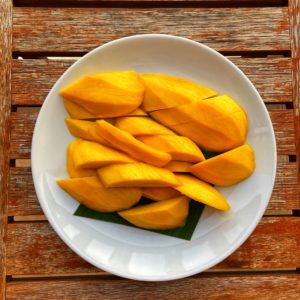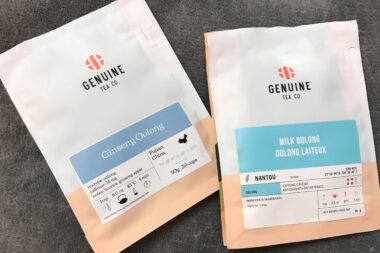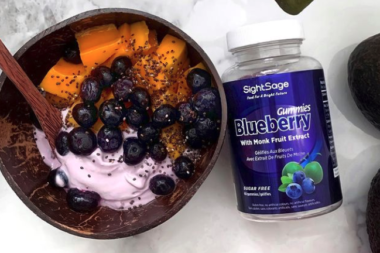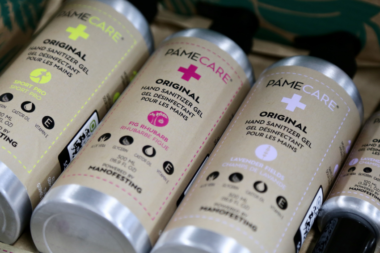Mango is a seasonal fruit, native to South Asia, with unprecedented love and fondness among the South Asians for this fruit. It is the national fruit of India and Pakistan and the national tree of Bangladesh. It is even called “the king of fruits” among the natives. The season of mangoes starts around May and ends around August/September, making it a fruit of peak summer. The season is enjoyed thoroughly and mango festivals are also held in some places. Mangoes are cherished from the earlier times, with the records of Mughal emperors, renowned poets of the subcontinent, and Sultans praising it. The nutritional value of a mango is 60 kcal/100 g, with vitamin C and folate present in significant amounts.
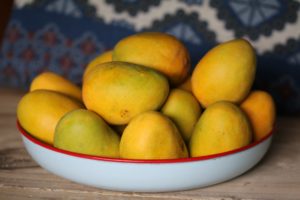 Forms and types – Natives enjoy mango in many ways. There are many kinds of the fruit. The sizes range from 5-25 centimetres, with slightly different textures among different kinds. Some of the common kinds include Sindhri, Langra, Totapoori, Dussehri, Chaunsa, and Anwar Ritol, and each one has different characteristics and is utilized in specified ways. At the beginning of the season, raw mangoes are cultivated and are abundantly available in the market.
Forms and types – Natives enjoy mango in many ways. There are many kinds of the fruit. The sizes range from 5-25 centimetres, with slightly different textures among different kinds. Some of the common kinds include Sindhri, Langra, Totapoori, Dussehri, Chaunsa, and Anwar Ritol, and each one has different characteristics and is utilized in specified ways. At the beginning of the season, raw mangoes are cultivated and are abundantly available in the market.
 The raw mangoes are sour and firm and are used in the making of chutneys, pickles, marmalades, and juices. It is also used in lentil and other curries to add a sweet and sour taste. While, the ripe mangoes are eaten on their own or are enjoyed as aamrus, aam panna, mango lassi or milkshake. Aamrus is simply the pulp of the fruit sometimes mixed with sugar, milk, or yogurt and enjoyed with chapatis. Aam panna is a famous mango drink, while mango lassi and milkshake are prepared by blending buttermilk or milk with the mango pulp, respectively. Aamchur powder is also prepared for mangoes, that is used in the main course dishes of South Asia.
The raw mangoes are sour and firm and are used in the making of chutneys, pickles, marmalades, and juices. It is also used in lentil and other curries to add a sweet and sour taste. While, the ripe mangoes are eaten on their own or are enjoyed as aamrus, aam panna, mango lassi or milkshake. Aamrus is simply the pulp of the fruit sometimes mixed with sugar, milk, or yogurt and enjoyed with chapatis. Aam panna is a famous mango drink, while mango lassi and milkshake are prepared by blending buttermilk or milk with the mango pulp, respectively. Aamchur powder is also prepared for mangoes, that is used in the main course dishes of South Asia.
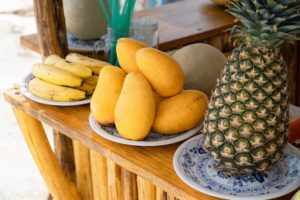 Nutritional Value – The energy value of a mango is 60 kcal per 100 grams of serving. A serving of a mango fulfils 44% of the daily requirement of Vitamin C, which aids immunity, iron absorption, growth, and repair. It also fulfils 11% of the daily requirement of folate. One cup of mangoes (165 g) contains 24.7 grams of carbohydrates, 1.4 grams of protein, 2.6 grams of dietary fiber, and only 0.6 grams of fat. Other than that, mangoes contain polyphenols, compounds that function as antioxidants, which means they protect the cells against free radical damage.
Nutritional Value – The energy value of a mango is 60 kcal per 100 grams of serving. A serving of a mango fulfils 44% of the daily requirement of Vitamin C, which aids immunity, iron absorption, growth, and repair. It also fulfils 11% of the daily requirement of folate. One cup of mangoes (165 g) contains 24.7 grams of carbohydrates, 1.4 grams of protein, 2.6 grams of dietary fiber, and only 0.6 grams of fat. Other than that, mangoes contain polyphenols, compounds that function as antioxidants, which means they protect the cells against free radical damage.
Benefits of Mangoes
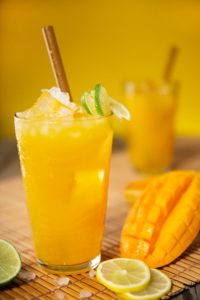 Aids Digestion – Mangoes contain a group of digestive enzymes called amylases, that break down large molecules of food for efficient absorption. The fruit is also enriched with fiber which maintains gut health and prevents and treats constipation and other digestion issues. The high water content allows food to pass through the gut easily. Many researches conclude a few other factors that make mango a fruit which aids digestion.
Aids Digestion – Mangoes contain a group of digestive enzymes called amylases, that break down large molecules of food for efficient absorption. The fruit is also enriched with fiber which maintains gut health and prevents and treats constipation and other digestion issues. The high water content allows food to pass through the gut easily. Many researches conclude a few other factors that make mango a fruit which aids digestion.
Strengthens Immune System – Mangoes provide a fine amount of Vitamin C and A and other compounds that strengthen the immune system. Vitamin C is known to help body fight against infections, repair the damaged tissues, and aid the absorption of iron. It is also high in antioxidants, that prevent the body from chronic diseases like heart disease.
Super Antioxidant – Mangoes have very powerful antioxidants, sometimes called “super antioxidants”, and thus prevent the body from free radical damage. Free radicals are highly active compounds found in the body, that bind to cells and damage them. They are known to cause the signs of aging and chronic diseases.
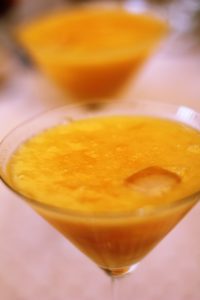 Promotes Hair and Skin health – The vitamin C found in mangoes is essential for the synthesis of collagen, a protein that gives structure to our hair and skin. Collagen is also important to maintain the firmness of skin which prevents sagging and wrinkles. Vitamin A is also present in mangoes, which again is a proven nutrient that encourages hair growth. It also protects the skin from harmful affects of ultraviolet rays of the sun.
Promotes Hair and Skin health – The vitamin C found in mangoes is essential for the synthesis of collagen, a protein that gives structure to our hair and skin. Collagen is also important to maintain the firmness of skin which prevents sagging and wrinkles. Vitamin A is also present in mangoes, which again is a proven nutrient that encourages hair growth. It also protects the skin from harmful affects of ultraviolet rays of the sun.
Promotes Heart Health – Various studies have shown the good affects of mangoes on heart. Mangoes have magnesium and potassium which help in dilation of blood vessels which in turn helps in preventing high blood pressures. The antioxidant “mangiferin” present in mangoes protects heart cells against inflammation, oxidative stress, and apoptosis.
Lowers Cholesterol Levels – The fibre, pectin, and Vitamin C present in the mangoes help in lowering the levels of cholesterol. Although the affects on High-level Lipoprotein (aka good cholesterol) are still unknown, affects on Low-level Lipoprotein (aka bad cholesterol) have been observed, which show that consuming mangoes reduces the level of LDL, thus maintaining cardiac health.
Easy-peasy Recipes
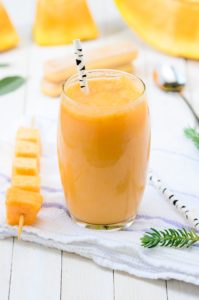 The fact that the mangoes have easy culinary uses gives us another reason to adore them even more. Following are some ways in which mangoes are enjoyed in the asian families:
The fact that the mangoes have easy culinary uses gives us another reason to adore them even more. Following are some ways in which mangoes are enjoyed in the asian families:
- Mango Milkshakes: Mangoes are blended with milk and sugar until desired consistency and are served chilled. This drink perfectly beats the heat of the hot days that are common in South Asia.
- Mango chutney: Mango chutney is a sauce prepared with the traditional spices such as turmeric, cumin, coriander, nigella seeds, and all-spices. The base is prepared with ginger-garlic and onions. This chutney is consumed in multiple ways. Another delicious sauce is also prepared with raw mangoes. It has a sweet and sour, tangy flavour. It is usually preferred with lunch time snacks and fried food items.
- Mango desserts: Mangoes are widely used for sweet dishes. Mango kheer, mango ice-cream, mango cheesecakes, mango kulfi, and mango pudding are few of the dishes which can be prepared at home with ease.
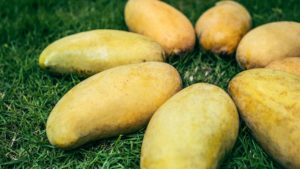
- Mango Panna Cotta: This is a light and creamy dessert, basically a form of the Italian delight. It is prepared with sweetened cream and gelatin, which makes it a melt-in-mouth delicacy.
These are some of the variations of mango recipes across South Asia. However, the fruit is best enjoyed on its own, either sliced or diced. The mere pulp of a mango tastes delicious and is served on its own to be eaten by spoon or with chapatis. In mango season, this combo of pulp and chapatis, sometimes takes over the main course dishes.

